Reflective Essay on Wrong Blood Transfusion: Nursing Implications
VerifiedAdded on 2023/06/09
|6
|1474
|75
Essay
AI Summary
This reflective essay analyzes a case of wrong blood transfusion involving Ms. Stoll, a 71-year-old patient who died due to receiving incompatible blood during surgery. The essay delves into the nursing errors, specifically the mislabeling of blood samples, and the resulting ABO incompatibility reaction that led to her death. It explores the emotional impact on the patient's family and the implications for nursing practice, emphasizing the need for adherence to National Safety and Quality Health Service Standards (NSQHC). The author reflects on the importance of patient involvement, proper labeling procedures, and the implementation of safety protocols to prevent such incidents. The essay concludes with an action plan for the nurse to prevent future errors, including a commitment to understanding and implementing NSQHC standards and reviewing relevant academic literature. The case underscores the significance of preventing wrong blood transfusions through meticulous attention to detail and rigorous adherence to established guidelines.
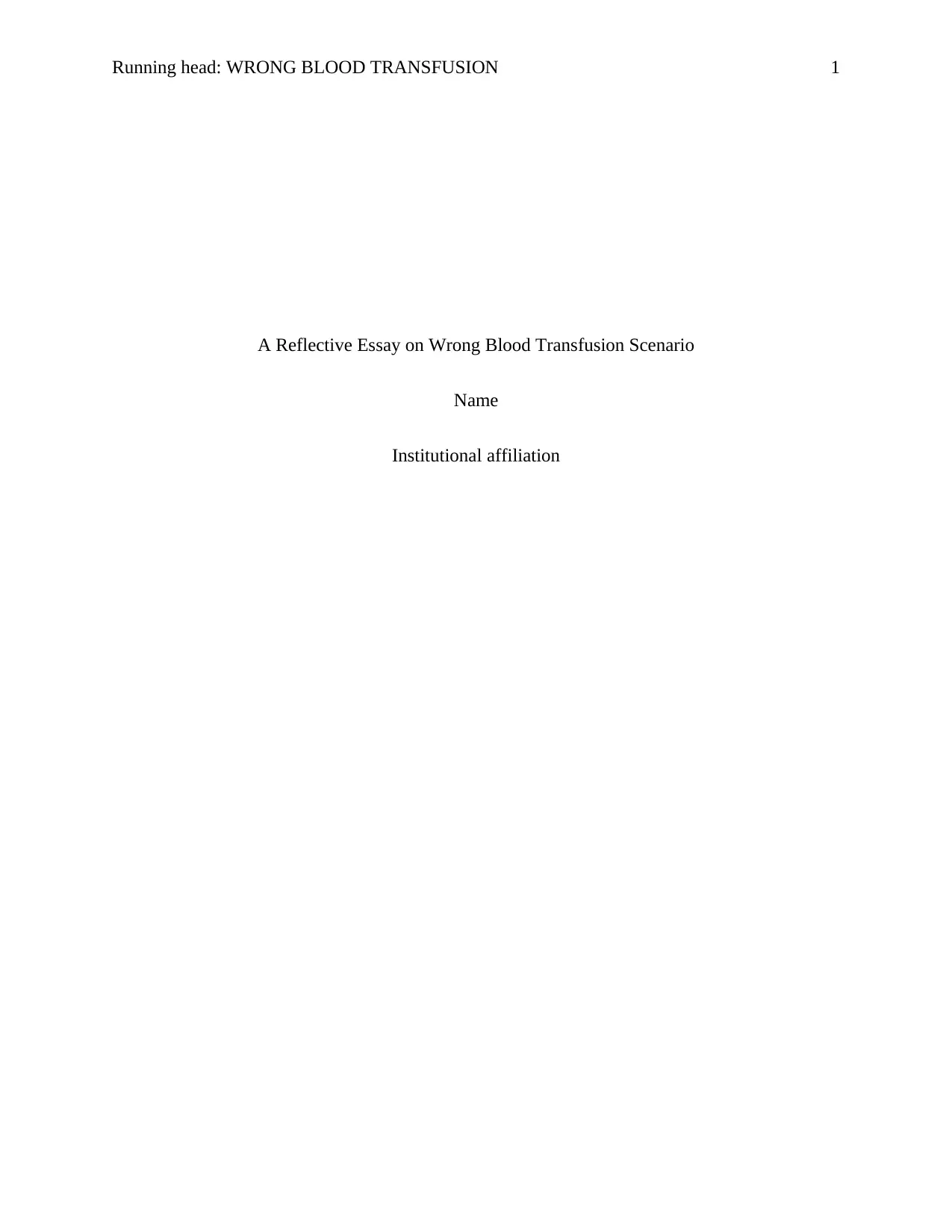
Running head: WRONG BLOOD TRANSFUSION 1
A Reflective Essay on Wrong Blood Transfusion Scenario
Name
Institutional affiliation
A Reflective Essay on Wrong Blood Transfusion Scenario
Name
Institutional affiliation
Paraphrase This Document
Need a fresh take? Get an instant paraphrase of this document with our AI Paraphraser
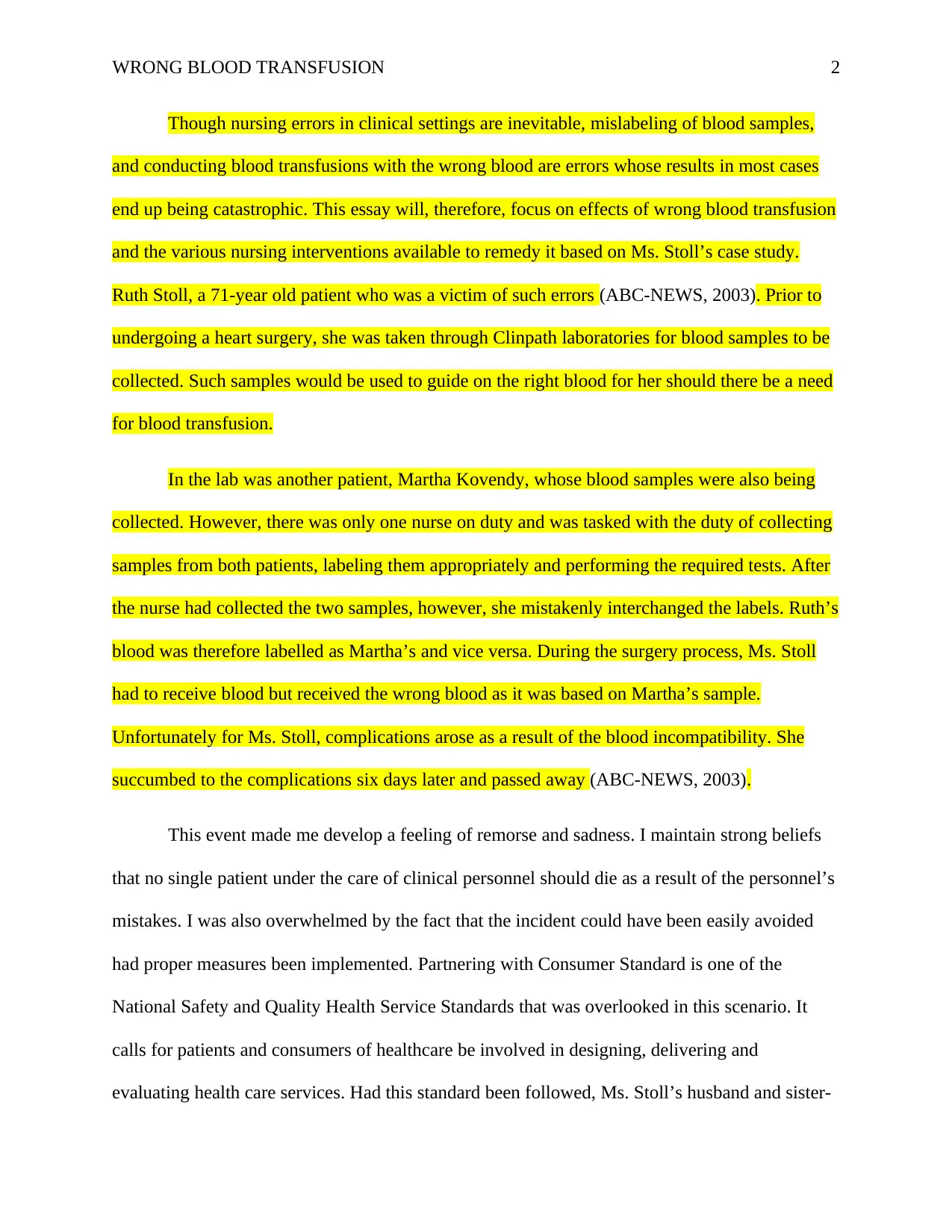
WRONG BLOOD TRANSFUSION 2
Though nursing errors in clinical settings are inevitable, mislabeling of blood samples,
and conducting blood transfusions with the wrong blood are errors whose results in most cases
end up being catastrophic. This essay will, therefore, focus on effects of wrong blood transfusion
and the various nursing interventions available to remedy it based on Ms. Stoll’s case study.
Ruth Stoll, a 71-year old patient who was a victim of such errors (ABC-NEWS, 2003). Prior to
undergoing a heart surgery, she was taken through Clinpath laboratories for blood samples to be
collected. Such samples would be used to guide on the right blood for her should there be a need
for blood transfusion.
In the lab was another patient, Martha Kovendy, whose blood samples were also being
collected. However, there was only one nurse on duty and was tasked with the duty of collecting
samples from both patients, labeling them appropriately and performing the required tests. After
the nurse had collected the two samples, however, she mistakenly interchanged the labels. Ruth’s
blood was therefore labelled as Martha’s and vice versa. During the surgery process, Ms. Stoll
had to receive blood but received the wrong blood as it was based on Martha’s sample.
Unfortunately for Ms. Stoll, complications arose as a result of the blood incompatibility. She
succumbed to the complications six days later and passed away (ABC-NEWS, 2003).
This event made me develop a feeling of remorse and sadness. I maintain strong beliefs
that no single patient under the care of clinical personnel should die as a result of the personnel’s
mistakes. I was also overwhelmed by the fact that the incident could have been easily avoided
had proper measures been implemented. Partnering with Consumer Standard is one of the
National Safety and Quality Health Service Standards that was overlooked in this scenario. It
calls for patients and consumers of healthcare be involved in designing, delivering and
evaluating health care services. Had this standard been followed, Ms. Stoll’s husband and sister-
Though nursing errors in clinical settings are inevitable, mislabeling of blood samples,
and conducting blood transfusions with the wrong blood are errors whose results in most cases
end up being catastrophic. This essay will, therefore, focus on effects of wrong blood transfusion
and the various nursing interventions available to remedy it based on Ms. Stoll’s case study.
Ruth Stoll, a 71-year old patient who was a victim of such errors (ABC-NEWS, 2003). Prior to
undergoing a heart surgery, she was taken through Clinpath laboratories for blood samples to be
collected. Such samples would be used to guide on the right blood for her should there be a need
for blood transfusion.
In the lab was another patient, Martha Kovendy, whose blood samples were also being
collected. However, there was only one nurse on duty and was tasked with the duty of collecting
samples from both patients, labeling them appropriately and performing the required tests. After
the nurse had collected the two samples, however, she mistakenly interchanged the labels. Ruth’s
blood was therefore labelled as Martha’s and vice versa. During the surgery process, Ms. Stoll
had to receive blood but received the wrong blood as it was based on Martha’s sample.
Unfortunately for Ms. Stoll, complications arose as a result of the blood incompatibility. She
succumbed to the complications six days later and passed away (ABC-NEWS, 2003).
This event made me develop a feeling of remorse and sadness. I maintain strong beliefs
that no single patient under the care of clinical personnel should die as a result of the personnel’s
mistakes. I was also overwhelmed by the fact that the incident could have been easily avoided
had proper measures been implemented. Partnering with Consumer Standard is one of the
National Safety and Quality Health Service Standards that was overlooked in this scenario. It
calls for patients and consumers of healthcare be involved in designing, delivering and
evaluating health care services. Had this standard been followed, Ms. Stoll’s husband and sister-
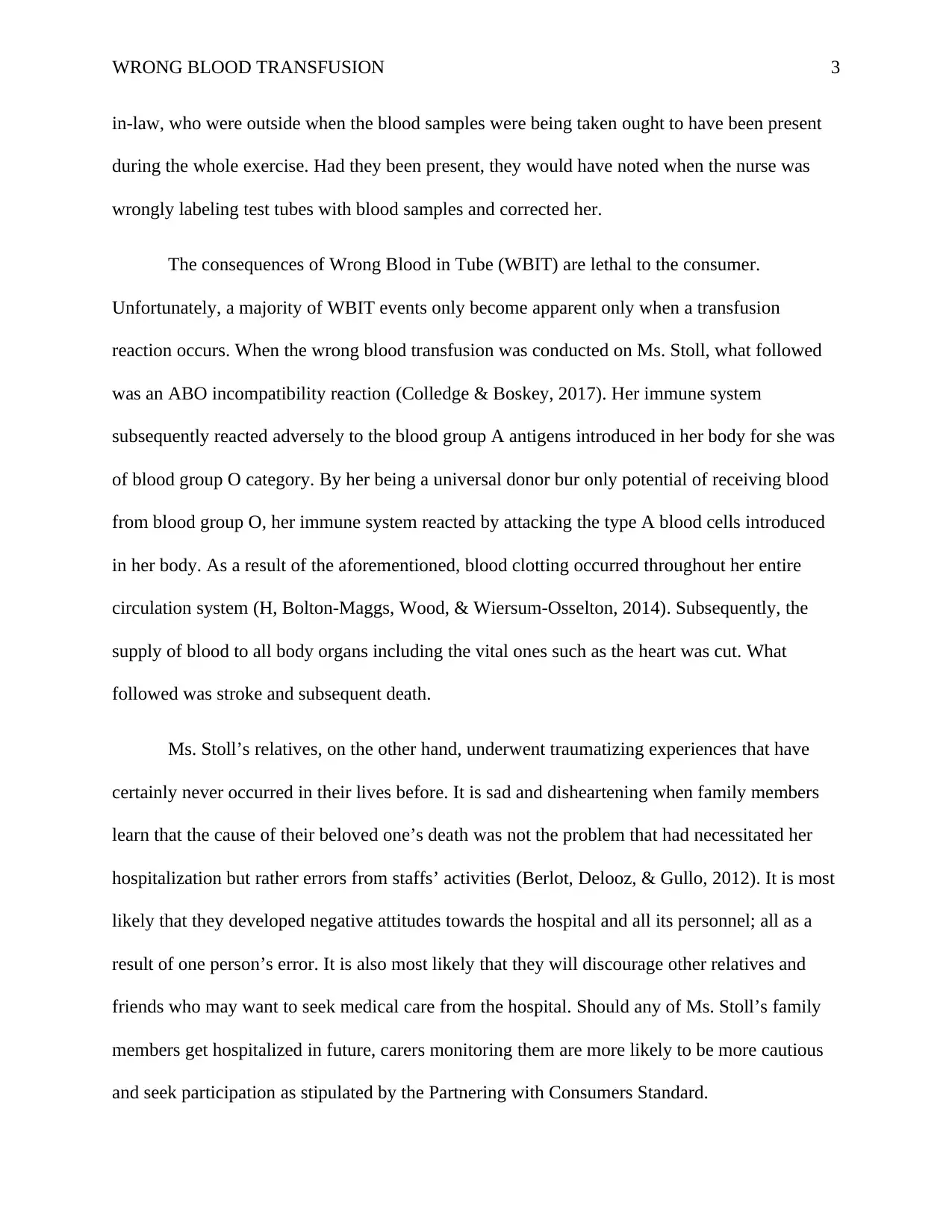
WRONG BLOOD TRANSFUSION 3
in-law, who were outside when the blood samples were being taken ought to have been present
during the whole exercise. Had they been present, they would have noted when the nurse was
wrongly labeling test tubes with blood samples and corrected her.
The consequences of Wrong Blood in Tube (WBIT) are lethal to the consumer.
Unfortunately, a majority of WBIT events only become apparent only when a transfusion
reaction occurs. When the wrong blood transfusion was conducted on Ms. Stoll, what followed
was an ABO incompatibility reaction (Colledge & Boskey, 2017). Her immune system
subsequently reacted adversely to the blood group A antigens introduced in her body for she was
of blood group O category. By her being a universal donor bur only potential of receiving blood
from blood group O, her immune system reacted by attacking the type A blood cells introduced
in her body. As a result of the aforementioned, blood clotting occurred throughout her entire
circulation system (H, Bolton‐Maggs, Wood, & Wiersum‐Osselton, 2014). Subsequently, the
supply of blood to all body organs including the vital ones such as the heart was cut. What
followed was stroke and subsequent death.
Ms. Stoll’s relatives, on the other hand, underwent traumatizing experiences that have
certainly never occurred in their lives before. It is sad and disheartening when family members
learn that the cause of their beloved one’s death was not the problem that had necessitated her
hospitalization but rather errors from staffs’ activities (Berlot, Delooz, & Gullo, 2012). It is most
likely that they developed negative attitudes towards the hospital and all its personnel; all as a
result of one person’s error. It is also most likely that they will discourage other relatives and
friends who may want to seek medical care from the hospital. Should any of Ms. Stoll’s family
members get hospitalized in future, carers monitoring them are more likely to be more cautious
and seek participation as stipulated by the Partnering with Consumers Standard.
in-law, who were outside when the blood samples were being taken ought to have been present
during the whole exercise. Had they been present, they would have noted when the nurse was
wrongly labeling test tubes with blood samples and corrected her.
The consequences of Wrong Blood in Tube (WBIT) are lethal to the consumer.
Unfortunately, a majority of WBIT events only become apparent only when a transfusion
reaction occurs. When the wrong blood transfusion was conducted on Ms. Stoll, what followed
was an ABO incompatibility reaction (Colledge & Boskey, 2017). Her immune system
subsequently reacted adversely to the blood group A antigens introduced in her body for she was
of blood group O category. By her being a universal donor bur only potential of receiving blood
from blood group O, her immune system reacted by attacking the type A blood cells introduced
in her body. As a result of the aforementioned, blood clotting occurred throughout her entire
circulation system (H, Bolton‐Maggs, Wood, & Wiersum‐Osselton, 2014). Subsequently, the
supply of blood to all body organs including the vital ones such as the heart was cut. What
followed was stroke and subsequent death.
Ms. Stoll’s relatives, on the other hand, underwent traumatizing experiences that have
certainly never occurred in their lives before. It is sad and disheartening when family members
learn that the cause of their beloved one’s death was not the problem that had necessitated her
hospitalization but rather errors from staffs’ activities (Berlot, Delooz, & Gullo, 2012). It is most
likely that they developed negative attitudes towards the hospital and all its personnel; all as a
result of one person’s error. It is also most likely that they will discourage other relatives and
friends who may want to seek medical care from the hospital. Should any of Ms. Stoll’s family
members get hospitalized in future, carers monitoring them are more likely to be more cautious
and seek participation as stipulated by the Partnering with Consumers Standard.
⊘ This is a preview!⊘
Do you want full access?
Subscribe today to unlock all pages.

Trusted by 1+ million students worldwide
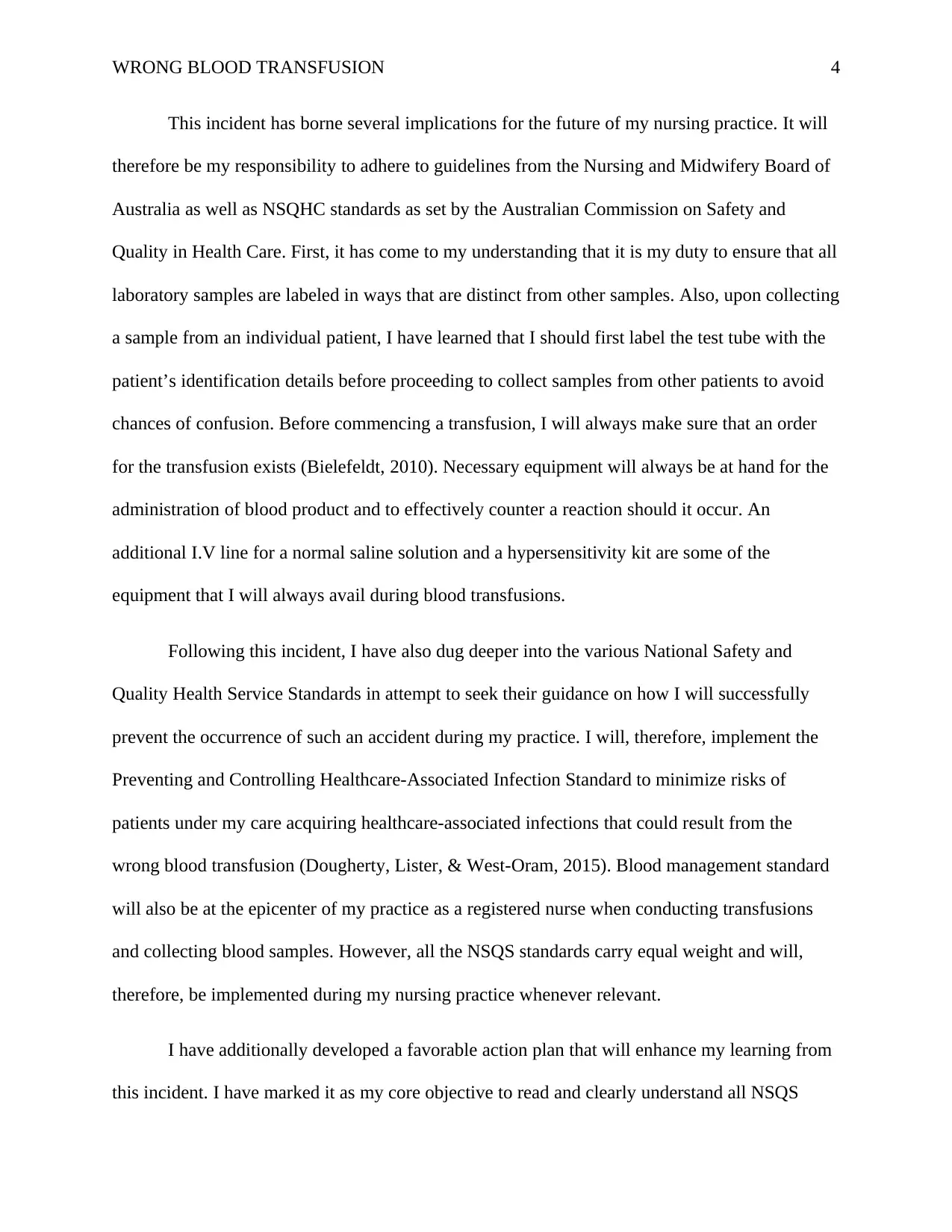
WRONG BLOOD TRANSFUSION 4
This incident has borne several implications for the future of my nursing practice. It will
therefore be my responsibility to adhere to guidelines from the Nursing and Midwifery Board of
Australia as well as NSQHC standards as set by the Australian Commission on Safety and
Quality in Health Care. First, it has come to my understanding that it is my duty to ensure that all
laboratory samples are labeled in ways that are distinct from other samples. Also, upon collecting
a sample from an individual patient, I have learned that I should first label the test tube with the
patient’s identification details before proceeding to collect samples from other patients to avoid
chances of confusion. Before commencing a transfusion, I will always make sure that an order
for the transfusion exists (Bielefeldt, 2010). Necessary equipment will always be at hand for the
administration of blood product and to effectively counter a reaction should it occur. An
additional I.V line for a normal saline solution and a hypersensitivity kit are some of the
equipment that I will always avail during blood transfusions.
Following this incident, I have also dug deeper into the various National Safety and
Quality Health Service Standards in attempt to seek their guidance on how I will successfully
prevent the occurrence of such an accident during my practice. I will, therefore, implement the
Preventing and Controlling Healthcare-Associated Infection Standard to minimize risks of
patients under my care acquiring healthcare-associated infections that could result from the
wrong blood transfusion (Dougherty, Lister, & West-Oram, 2015). Blood management standard
will also be at the epicenter of my practice as a registered nurse when conducting transfusions
and collecting blood samples. However, all the NSQS standards carry equal weight and will,
therefore, be implemented during my nursing practice whenever relevant.
I have additionally developed a favorable action plan that will enhance my learning from
this incident. I have marked it as my core objective to read and clearly understand all NSQS
This incident has borne several implications for the future of my nursing practice. It will
therefore be my responsibility to adhere to guidelines from the Nursing and Midwifery Board of
Australia as well as NSQHC standards as set by the Australian Commission on Safety and
Quality in Health Care. First, it has come to my understanding that it is my duty to ensure that all
laboratory samples are labeled in ways that are distinct from other samples. Also, upon collecting
a sample from an individual patient, I have learned that I should first label the test tube with the
patient’s identification details before proceeding to collect samples from other patients to avoid
chances of confusion. Before commencing a transfusion, I will always make sure that an order
for the transfusion exists (Bielefeldt, 2010). Necessary equipment will always be at hand for the
administration of blood product and to effectively counter a reaction should it occur. An
additional I.V line for a normal saline solution and a hypersensitivity kit are some of the
equipment that I will always avail during blood transfusions.
Following this incident, I have also dug deeper into the various National Safety and
Quality Health Service Standards in attempt to seek their guidance on how I will successfully
prevent the occurrence of such an accident during my practice. I will, therefore, implement the
Preventing and Controlling Healthcare-Associated Infection Standard to minimize risks of
patients under my care acquiring healthcare-associated infections that could result from the
wrong blood transfusion (Dougherty, Lister, & West-Oram, 2015). Blood management standard
will also be at the epicenter of my practice as a registered nurse when conducting transfusions
and collecting blood samples. However, all the NSQS standards carry equal weight and will,
therefore, be implemented during my nursing practice whenever relevant.
I have additionally developed a favorable action plan that will enhance my learning from
this incident. I have marked it as my core objective to read and clearly understand all NSQS
Paraphrase This Document
Need a fresh take? Get an instant paraphrase of this document with our AI Paraphraser

WRONG BLOOD TRANSFUSION 5
standards. I will also read relevant peer-reviewed academic materials to empower myself with
information previously coined to curb such incidents.
In conclusion, this essay has highlighted the entire scene where a patient died as a result
of wrong blood transfusion. Documented also are the consequences of the transfusion on the
patient’s health as well as all the possible reactions that could have been developed by the
patient’s relatives. Various nursing interventions with the potential to prevent re-occurrence of
such an incident have been highlighted.
standards. I will also read relevant peer-reviewed academic materials to empower myself with
information previously coined to curb such incidents.
In conclusion, this essay has highlighted the entire scene where a patient died as a result
of wrong blood transfusion. Documented also are the consequences of the transfusion on the
patient’s health as well as all the possible reactions that could have been developed by the
patient’s relatives. Various nursing interventions with the potential to prevent re-occurrence of
such an incident have been highlighted.
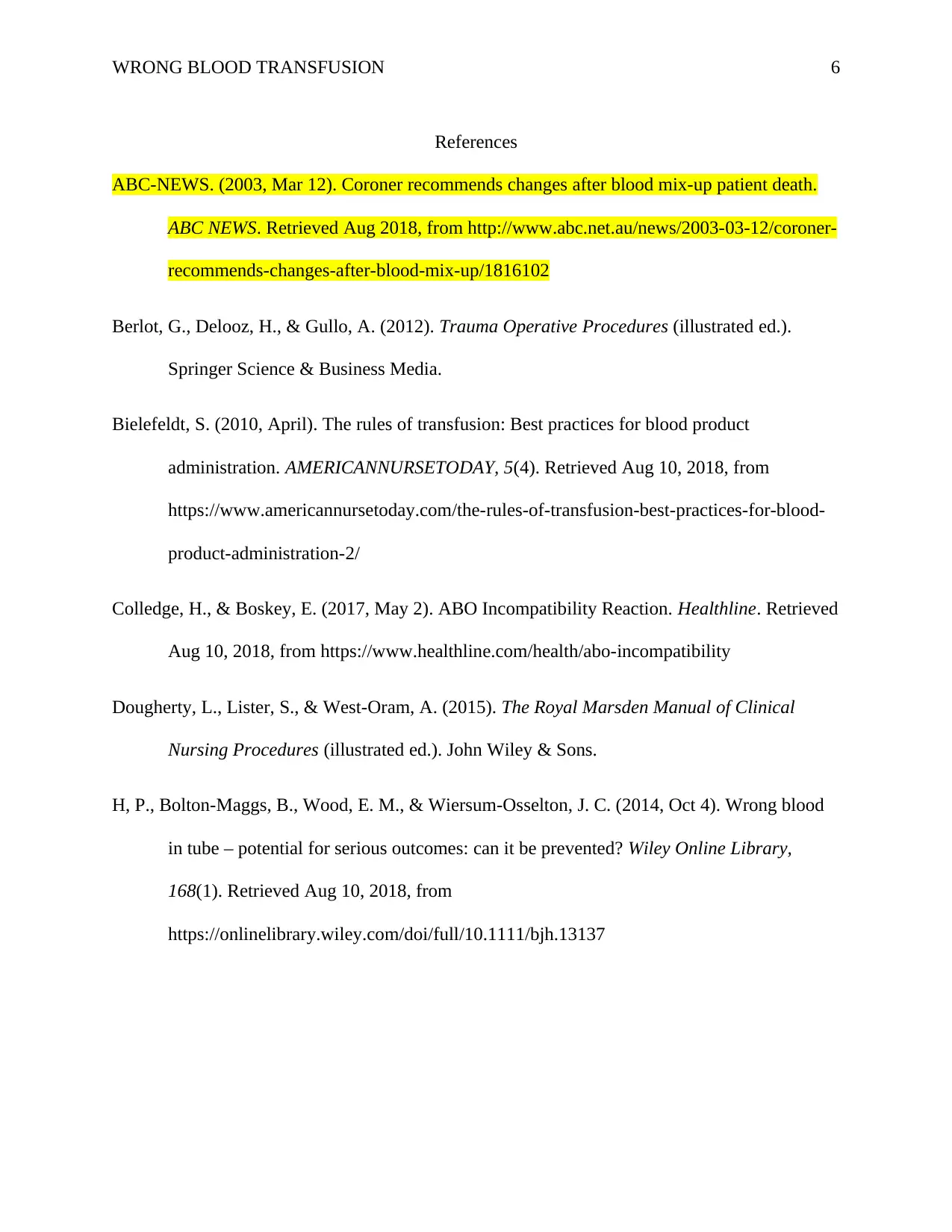
WRONG BLOOD TRANSFUSION 6
References
ABC-NEWS. (2003, Mar 12). Coroner recommends changes after blood mix-up patient death.
ABC NEWS. Retrieved Aug 2018, from http://www.abc.net.au/news/2003-03-12/coroner-
recommends-changes-after-blood-mix-up/1816102
Berlot, G., Delooz, H., & Gullo, A. (2012). Trauma Operative Procedures (illustrated ed.).
Springer Science & Business Media.
Bielefeldt, S. (2010, April). The rules of transfusion: Best practices for blood product
administration. AMERICANNURSETODAY, 5(4). Retrieved Aug 10, 2018, from
https://www.americannursetoday.com/the-rules-of-transfusion-best-practices-for-blood-
product-administration-2/
Colledge, H., & Boskey, E. (2017, May 2). ABO Incompatibility Reaction. Healthline. Retrieved
Aug 10, 2018, from https://www.healthline.com/health/abo-incompatibility
Dougherty, L., Lister, S., & West-Oram, A. (2015). The Royal Marsden Manual of Clinical
Nursing Procedures (illustrated ed.). John Wiley & Sons.
H, P., Bolton‐Maggs, B., Wood, E. M., & Wiersum‐Osselton, J. C. (2014, Oct 4). Wrong blood
in tube – potential for serious outcomes: can it be prevented? Wiley Online Library,
168(1). Retrieved Aug 10, 2018, from
https://onlinelibrary.wiley.com/doi/full/10.1111/bjh.13137
References
ABC-NEWS. (2003, Mar 12). Coroner recommends changes after blood mix-up patient death.
ABC NEWS. Retrieved Aug 2018, from http://www.abc.net.au/news/2003-03-12/coroner-
recommends-changes-after-blood-mix-up/1816102
Berlot, G., Delooz, H., & Gullo, A. (2012). Trauma Operative Procedures (illustrated ed.).
Springer Science & Business Media.
Bielefeldt, S. (2010, April). The rules of transfusion: Best practices for blood product
administration. AMERICANNURSETODAY, 5(4). Retrieved Aug 10, 2018, from
https://www.americannursetoday.com/the-rules-of-transfusion-best-practices-for-blood-
product-administration-2/
Colledge, H., & Boskey, E. (2017, May 2). ABO Incompatibility Reaction. Healthline. Retrieved
Aug 10, 2018, from https://www.healthline.com/health/abo-incompatibility
Dougherty, L., Lister, S., & West-Oram, A. (2015). The Royal Marsden Manual of Clinical
Nursing Procedures (illustrated ed.). John Wiley & Sons.
H, P., Bolton‐Maggs, B., Wood, E. M., & Wiersum‐Osselton, J. C. (2014, Oct 4). Wrong blood
in tube – potential for serious outcomes: can it be prevented? Wiley Online Library,
168(1). Retrieved Aug 10, 2018, from
https://onlinelibrary.wiley.com/doi/full/10.1111/bjh.13137
⊘ This is a preview!⊘
Do you want full access?
Subscribe today to unlock all pages.

Trusted by 1+ million students worldwide
1 out of 6
Related Documents
Your All-in-One AI-Powered Toolkit for Academic Success.
+13062052269
info@desklib.com
Available 24*7 on WhatsApp / Email
![[object Object]](/_next/static/media/star-bottom.7253800d.svg)
Unlock your academic potential
Copyright © 2020–2025 A2Z Services. All Rights Reserved. Developed and managed by ZUCOL.





